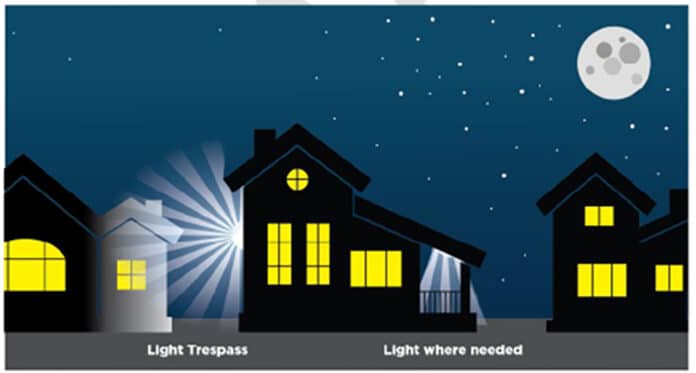Hello,
Because of my passion for astronomy, the spread of Artificial Light At Night (ALAN) is of great concern to me. However, it’s fast becoming the case that this seemingly unstoppable spread should be of concern to everyone. Researchers have now looked beyond its effects on astronomy, and this is what I’m going to share here. With more lights going on now that the darker evenings are here, I felt this would be timely. What follows is a constrained overview compiled from a variety of sources, which I can make available on request.
But what is light pollution?
Many people just aren’t aware of what constitutes light pollution. Basically, though, it’s ALAN levels in excess of what’s needed, and/or miss-directed. So, if you’re using a 1000 watt light just to illuminate your front step, or your external lights are sending light upwards and outwards instead of down to where it’s needed, or your lighting is illuminating other people’s property or areas used by wildlife, then that’s light pollution. It’s pretty simple if you think of light pollution as being analogous to noise pollution.
Human health
Research has shown that ALAN can negatively affect human health, increasing risks for obesity, depression, sleep disorders, stress, diabetes, breast and prostate cancer, and more.
Our bodies produce the hormone melatonin in response to circadian rhythm. Melatonin helps keep us healthy. It has antioxidant properties, induces sleep, boosts the immune system, lowers cholesterol, and helps the functioning of the thyroid, pancreas, ovaries, testes and adrenal glands. Night-time exposure to artificial light suppresses melatonin production.
Furthermore, inappropriately bright or miss-directed lighting at night time intended to light our way can actually have the opposite result: dazzling our eyes, and casting deep shadows that obscure obstacles and hazards.
Wildlife
If the direct impact on human health isn’t scary enough, then this is where things get really serious. As we know, many insects are drawn to light, but this can be a fatal attraction. Declining insect populations negatively impact all species that rely on them for food or pollination. Some predators exploit this attraction to their advantage, affecting food webs in unanticipated ways. Research has shown that of all the invertebrates attracted to artificial light, one third will die as a direct result (simple exhaustion being a major factor).
In fact, it’s been shown that the overall cause of insect decline in recent years has been due to artificial lighting at night. Moth and butterfly caterpillar numbers, for example, in areas affected by artificial lighting, can be as low as 52% of what they are in unaffected areas. The knock-on impact of this is scary. Daytime pollinators need night-time darkness to sleep, night-time pollinators need darkness to grow, develop, reproduce and generally go about their business. We are all more aware of the impact of insect decline these days, but, to put this into context, did you know that a single pair of Blue Tits needs to find around 15,000 caterpillars to raise a brood successfully. Half the number of insects means half the number of birds, half the levels of pollination, half the amount of food … and so it goes on.
Light pollution has a major impact on nocturnal mammals, too, affecting some animals’ ability to hunt, whilst making it easier for predators to hunt them, and affecting hibernation…
Glare from artificial lights can also impact wetland habitats that are home to amphibians, whose night-time croaking is part of the breeding ritual. Artificial lights disrupt this nocturnal activity, interfering with reproduction and reducing populations.
In short, all aspects of wildlife activity are negatively affected by artificial light at night: breeding, feeding, migration, hibernation, raising young, etc.
Crops
Recent studies have shown that ALAN causes developmental issues with farmed crops. Instead of producing fruit or seeds, in sync with the passing of the seasons, crops can continue to what’s called ‘vegetate’, that is the plant continues to grow and produce leaves, ‘thinking’ that it’s not yet time to flower/fruit.
Suggestions
Don’t get me wrong, I’m not trying to be like some stern ARP warden from the ‘40s shouting ‘turn off that light!’ However, we do all need to be more aware of what constitutes light pollution, and how it does and will affect humans and the wider environment. Consider using ALAN appropriately. Direct it down to where it’s needed, not out and/or up. If you can’t replace it, consider fitting a shade of some kind. Use only the intensity (brightness) that you actually need (fit low wattage bulbs). Don’t leave exterior lighting on all night (perhaps fit lighting that features a motion detector, so it’s only on for the brief time when it’s needed). If your business or other external lighting is set by a timer to go off at 10 or 11PM, for example, how about setting it to go off an hour or two earlier? Further advice and assistance can be obtained from your local council’s Environmental Health department.
Conclusions
As we all become increasingly aware of the threat of climate change and biodiversity decline it’s clear that we should all be doing what we can, starting with the simple things. Unlike other forms of pollution (water, air, industrial, oil, plastic, etc), light pollution requires no expensive cleanup efforts. Once the light is switched off, that’s it, it’s gone. Instantly, nocturnal birds, mammals, amphibians and insects can get back to doing what they need to do, the health risks for humans are gone, our carbon footprint is reduced, we save money … and yes, okay … everyone gets to enjoy a dark sky ????
If you like our content please keep us going for as little as £2 a month https://dorseteye.com/donate/







